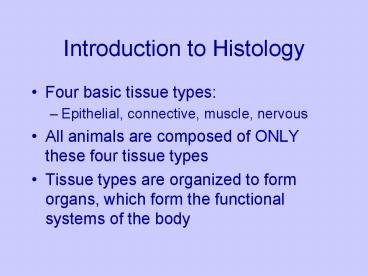Introduction to Histology - PowerPoint PPT Presentation
1 / 31
Title:
Introduction to Histology
Description:
All animals are composed of ONLY these four tissue types ... Hyaline: ribs, trachea. Elastic: ears, larynx. Fibro: spinal chord. p. 160 D. Examples: Connective ... – PowerPoint PPT presentation
Number of Views:2567
Avg rating:3.0/5.0
Title: Introduction to Histology
1
Introduction to Histology
- Four basic tissue types
- Epithelial, connective, muscle, nervous
- All animals are composed of ONLY these four
tissue types - Tissue types are organized to form organs, which
form the functional systems of the body
2
Epithelial tissue
- Function covers the internal and external
surfaces of the body - Four types Squamous, cuboidal, columnar, and
transitional - Organized in layers simple or stratified
3
Examples Epithelial
- Transitional epithelial found in the bladder
- Stretches as the bladder becomes full
p. 158 F draw above
4
Examples Epithelial
- Simple squamous lines blood vessels and lungs
- Allows for increased blood flow and increased
oxygen diffusion
p. 157 A
5
Examples Epithelial
- Stratified squamous lines the mouth, esophagus,
cervix and skin - Several layers offers protection to outer layers
and membranes of body.
p. 157 B
6
Examples Epithelial
- Simple columnar digestive tracts
- Cells mixed with goblet cells that secrete mucous
to aid in digestion
p. 158 D
7
8
Connective
- Function Bind and support other tissues
- Several types
- Bone
- Blood
- CT proper dense and loose
- Adipose
- Cartilage
9
Examples Connective
- CT proper
- Loose ECM
- Dense tendons and ligaments
p. 159 A
10
Examples Connective
- Bone
p. 161 E
11
Examples Connective
- Blood
- To circulate materials throughout the organism
- RBCs contain hemoglobin to allow for oxygen to
be carried to the tissues.
p. 160 C
12
Examples Connective
- Cartilage vary in of fibers
- Hyaline ribs, trachea
- Elastic ears, larynx
- Fibro spinal chord
p. 160 D
13
Examples Connective
- Adipose tissue
- Insulation
- Storage
p. 159 A
14
Muscle tissue
- Function Able to contract for locomotion.
- Three types skeletal, cardiac and smooth
15
Muscle tissue
- Skeletal voluntary, striated, multinucleate
cells - Muscles attached to bones for voluntary movement
p. 161 A
16
Muscle tissue
- Smooth
- Non-striated, spindle-shaped, uni-nucleate
involuntary cells - Muscles found in digestive tract, respiratory
tract, etc.
p. 161 B
17
Muscle tissue
- Cardiacinvoluntary, striated, branched,
uni-nucleate cells - Only found in the heart
p. 161 D
18
Nervous tissue
- Function Respond to
- stimuli and transmit impulses.
- Cells are called neurons
- Composed of cell body, axon and dendrites.
- Single cell may run up to several feet long.
p. 161 IV
19
Mystery Slides Lab activity
- Pick a Partner
- Go online and view the Mystery Slides in the
Jost Student Histology Powerpoint on the
Biology 102 website. - In each case, healthy tissue is on left and
diseased/damaged tissue is on right.
20
- Blocked coronary artery
21
- Alveoli of lungs with pneumonia
22
- Emphysema in alveoli of lungs
23
- Sickle cell anemia
24
- Parkinsons disease
25
- Cervical Human papillomavirus
26
- Herpes on esophagus
27
- Osteoporosis
28
- Infected mammary gland from silicone leak
29
- Stomach ulcer
30
- Cardiac tissue after cocaine use
31
- Cardiac tissue following myocardial infarction































